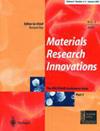介孔NiWO4@rGO纳米颗粒作为锂离子电池负极材料
Q2 Engineering
引用次数: 0
摘要
摘要:本文试图探索介孔NiWO4作为锂离子电池(LIB)阳极的电荷存储性能。首次采用单锅溶剂热合成方法对还原氧化石墨烯(rGO)制备的介孔NiWO4纳米颗粒进行了性能调整,并探索了其在锂离子电池阳极上的应用。利用结构和形态表征来证实电化学性能与石墨烯添加之间的关系,对材料进行了很好的表征。在100 mA g−1时,NiWO4@rGO (NWZC)的初始放电容量为1439 mAh g−1,高于NiWO4 (NWZ)。NWZ和NWZC的初始哥伦比亚效率分别为91.65%和62.1%。循环500次后,NWZ和NWZC的哥伦比亚效率均在99%以上。NWZC的锂离子存储性能的提高可能是NiWO4与r-GO的协同作用所致。图形抽象本文章由计算机程序翻译,如有差异,请以英文原文为准。
Mesoporous NiWO4@rGO nanoparticles as anode material for lithium-ion battery
ABSTRACT Herein, we have tried to explore the charge storage properties of mesoporous NiWO4 as an anode in lithium-ion batteries (LIB). A one pot-solvothermal synthesis is used to tweak the properties of mesoporous NiWO4 nanoparticles with reduced graphene oxide (rGO) for the first time and explored the LIB anode applications. Materials are well characterised using structural and morphological characterisations to corroborate the relation between the electrochemical properties and the graphene addition. At 100 mA g−1, the NiWO4@rGO (NWZC) exhibits initial discharge capacity of 1439 mAh g−1, which is more than that of NiWO4 (NWZ). Both NWZ and NWZC display initial coloumbic efficiency of 91.65% and 62.1%. After 500 cycles, the coloumbic efficiency of the NWZ and NWZC is above 99%. The improved lithium-ion storage characteristics of the NWZC may be from the synergetic effect between NiWO4 and r-GO. GRAPHICAL ABSTRACT
求助全文
通过发布文献求助,成功后即可免费获取论文全文。
去求助
来源期刊

Materials Research Innovations
工程技术-材料科学:综合
CiteScore
5.20
自引率
0.00%
发文量
38
审稿时长
2.8 months
期刊介绍:
Materials Research Innovations covers all areas of materials research with a particular interest in synthesis, processing, and properties from the nanoscale to the microscale to the bulk. Coverage includes all classes of material – ceramics, metals, and polymers; semiconductors and other functional materials; organic and inorganic materials – alone or in combination as composites. Innovation in composition and processing to impart special properties to bulk materials and coatings, and for innovative applications in technology, represents a strong focus. The journal attempts to balance enduring themes of science and engineering with the innovation provided by such areas of research activity.
 求助内容:
求助内容: 应助结果提醒方式:
应助结果提醒方式:


